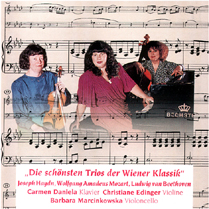|
Joseph Haydn, Wolfgang Amadeus Mozart, Ludwig van Beethoven
Joseph Haydn (1732 - 1809)
Trio E-Dur, Hob. XV:
Allegro moderato
Allegretto
Finale-Allegro
Wolfgang Amadeus Mozart (1756 - 1791)
Trio B-Dur, KV 502
Allegro
Larghetto
Allegretto
Ludwig van Beethoven (1770 - 1827)
Trio Es-Dur Op 1/1
Allegro
Adagio cantabile
Scherzo, Allegro assai
Finale, Presto
Allegretto
Larghetto
Scherzo, Allegro assai
Finale, Presto
Carmen Daniela Piano Christiane Edinger Violine Barbara Marcinkowska Violoncello
The trio sonata has its roots in the Baroque. Joseph Haydn, the
classical composer, however, did not take up with the Baroque but
created the foundations for a new line of tradition picked up by Mozart
and Beethoven with some generic refinements. This CD documents the
course of development of the classical piano trio.
Joseph Haydn composed his piano trios in rapid succession in the
years between 1784 and 1795, commissioned by the London music-publisher
Forster. The pieces are not the reflection of the composer's creed, but
owe their existence rather more to economic reasons. Thanks to his piano
trios, Haydn, well-known for his symphonies and choral works, could now
be supplied and consumed in that segment of the market represented by
Hausmusik. He wrote about 30 trios for this market, and they are marked
by the fact that the piano dominates the musical happening while the two
strings as a rule have only colouring functions. This remarkable
after-effect of the ad libitum principle becomes apparent in its scarce
treatment of the violin and and its even scarcer treatment of the cello
as obligatory instruments. Today we tend to overlook the fact that this
phenomenon was clearly expressed in the naming of sonatas till well into
Beethoven's time. The literal translation of the titles of old editions
of Haydn trios in the German-speaking world for instance is Sonatas for harpsichord or pianoforte accompanied by a violin and a violoncello.
Using the Trio Sonata in E major as an example, we see that, due to a
clever translation of piano-like changes into a violin-like manner, the
violin seems to be far more independent than it is according to the
musical substance. In the first movement, of course, it is up to the
piano to present the theme sotto voce in its full harmonic range in a
replete four-part writing, having introduced the theme distinctively as a
slightly ornamental, distinctive pizzicato. The second movement's
designation as allegretto might mislead the listener at first:
the designation obscures the fact that, in reality, the movement is very
emotional, drawing on great inner tranquility. The contrast between the
even quavers in the secondary part - mainly in bass, later transposed
into descant - and the melody line, rhythmically relaxed and thus
ornamented but nevertheless smoothly flowing. Violin and violoncello
have no other tasks in this movement but to enhance the effects. The
piano is the uncontested centre and vehicle of the musical happening.
The final movement is a playful, entertaining and friendly rondo that,
even in its episodes in a minor key, stays light and unthreatening.
Seven piano trios by Mozart have come down to us, six of which were
composed in Vienna in 1786 and thereafter. The Trio in B Flat Major,
written in November 1786, is a favourite with audiences, as it combines
concertant elements so smoothly with the chamber music framework. The
opening allegro displays a chromatically coloured main theme presided in
thirds that does not leave room for an independent second idea until
rather late. Parallel to Haydn, Mozart also lets the piano have the
central musical part in a quiet larghetto. Once conquered, the terrain
is not yielded in the final rondo: the result is a piano concerto en
miniature in the guise of chamber music.
What distance the piano trio genre has covered from Haydn to Beethoven is best seen in Beethoven's choice of a group of three piano trios to be his Opus 1
with which he wanted to establish his name as a composer. Beethoven's
pupil, Ferdinand Ries, reported that Haydn himself was present at this
concert at Prince Carl von Lichnowsky's, to whom it was dedicated. Haydn
is said to have shown some enthusiasm - in particular about the first
two in E flat major and G major.
For a first work, the trios display quite a surprising level of
maturity, mostly in their interlinking and the distribution of the tasks
of the musical happening to all three instruments. The Trio in E Flat
Major of 1793/94 is the one among all Beethoven's piano trios which, due
to its perfect craftmanship, paved the way for those works that were to
be rejected by his contemporaries for their modernity and the courage
of their ideas. We are fascinated here without restriction by the
variety of the themes and motifs, the detailed elaboration, the
abundance of ideas and the tendency to great air and effectful sound.
Potsdam-born Christiane Edinger's high standard of
interpretational art and technique is based on her studies with Vittorio
Brero at the Berlin Musikhochschule. Later the violinist perfected her
training at the Juilliard School of Music in New York under Joseph Fuchs
and Nathan Milstein. Christane Edinger made her first appearance as a
soloist with the Berlin Philharmonic Orchestra when she was but 19 years
old. This started an international career which brought her together
with leading orchestras in Europe and America. She regularly tours Asia,
Latin America and even the CIS. Christiane Edinger has made several
recordings in Europe and America and has participated in numerous radio
and TV recordings. Her artistic achievements have been acknowledged by
the Music Award of the City of Berlin and the German Critics' Award.
Our price: 13,45 EUR
incl. 19.0% MWSt. / VAT
|

